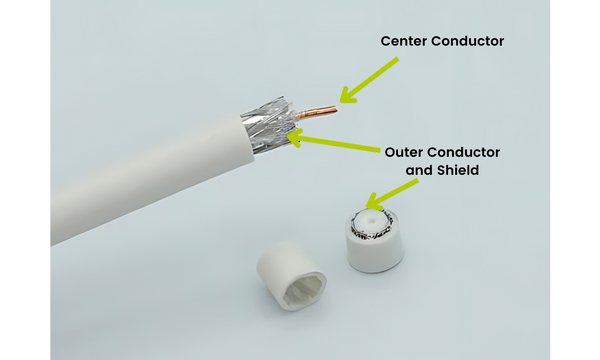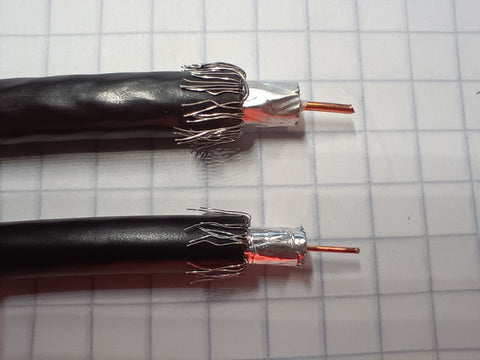Payment methods accepted

RG59 vs RG6: Key Differences And Which Coaxial Cable Is Best For You
Written by Dave Harris, trueCABLE Technical Specialist, BICSI INST1, INSTC Certified
Coaxial cables are an essential component in many audio and video systems, including cable television, CCTV installations, and satellite TV signals. When it comes to choosing the right coaxial cable, two common options are RG59 and RG6. These cables differ in terms of their construction, bandwidth capabilities, and applications. In this article, we will explore the differences between RG59 and RG6 coaxial cables, their applications, and the factors to consider when selecting the appropriate cable for your needs.
A quick note on nomenclature
In this article, we will focus on two common types: RG6 and RG59 coaxial cables. The name “RG6” has recently been changed to be “Series-6.” Similarly, “RG59” has been renamed to “Series-59.” To avoid confusion, this article will use the terms “RG6” and “RG59,“ as they remain the terms in common use.
Feel free to follow along with the video below!
What is a Coaxial Cable?
Before delving into the differences between RG59 and RG6 cables, let's first understand what a coaxial cable is. A coaxial cable is a type of cable that consists of a center conductor enveloped by insulation and grounded protection of braided wire. The primary purpose of a coaxial cable is to carry high-frequency signals with minimal interference.

Figure 1. Structure of a coaxial cable
Coaxial cables are widely used in various industries, including telecommunications, audio and video systems, and networking. They are known for their reliable signal transmission capabilities and effective shielding against external interference.
You can learn more about the construction of coaxial cable in our Cable Academy blog article, Coaxial vs Ethernet cable - What's the Difference?
What Does RG Mean?
Coaxial cables use RG ratings as a classification system to differentiate between different types of cables. RG stands for "radio guide," which is an old military term. The RG ratings are randomly assigned numbers that distinguish the different RG6 and RG59 cable specifications. In this article, we will focus on two common types: RG6 and RG59 coaxial cables.
RG6 Coaxial Cable: High-Bandwidth Applications
RG6 coaxial cable is a heavier gauge cable designed for high-bandwidth, high-frequency applications. It is commonly used for internet, cable TV, and satellite TV signals. The larger conductor and thicker dielectric insulation of RG6 cable allow for better signal quality and improved performance.
One of the key advantages of RG6 cable is its ability to handle higher frequencies. If your equipment operates at frequencies above 50 MHz, such as satellite receivers or broadband internet, RG6 is the recommended choice. RG6 coaxial cable also features a different type of shielding, which enables it to effectively handle Gigahertz-level signals.
The shielding of RG6 coaxial cable is typically a combination of foil and braided shielding. The foil shielding protects against high-frequency electromagnetic interference (EMI), while the braided shielding offers protection against lower-frequency interference. This dual shielding ensures a high level of signal integrity and minimizes signal loss.
RG59 Coaxial Cable: Low-Bandwidth Applications
RG59 coaxial cable is a thinner cable primarily recommended for low-bandwidth and lower frequency applications. It was commonly used for analog video signals and CCTV installations. However, with the advent of digital technology and higher frequencies, RG59 cable has become less popular in recent years.
Compared to RG6 cable, RG59 has a smaller conductor and thinner dielectric insulation. These factors result in limited signal quality, making it less suitable for high-frequency applications. The shielding of RG59 cable is designed to handle relatively long waveforms of megahertz interference, making it ideal for low-frequency signals below 50 MHz.
RG59 coaxial cable typically features braided shielding, which provides protection against lower-frequency interference. It is commonly used for composite or component video signals and closed-circuit television (CCTV) systems. RG59 cables are also available in a Siamese coaxial cable configuration, which combines RG59 cable with a 2C power cable, allowing for simultaneous power and video transmission in CCTV installations.
Differences Between RG59 and RG6 Cables
To summarize the key differences between RG59 and RG6 coaxial cables:
| Aspect | RG59 Coaxial Cable | RG6 Coaxial Cable |
|---|---|---|
| Conductor Size | Smaller (20 AWG) | Larger (18 AWG) |
| Dielectric Insulation | Thinner | Thicker |
| Recommended Frequencies | Below 50 MHz | Above 50 MHz |
| Applications | Analog video, CCTV | Internet, cable TV, Satellite TV |
| Shielding | Braided | Combination of foil and braided |
| Signal Loss (Attenuation) | Higher | Lower |
It is important to consider the specific requirements of your equipment and the frequencies it operates at when choosing between RG59 and RG6 coaxial cables. RG6 is generally the more versatile option, offering better signal quality and bandwidth capabilities for a wide range of applications.

Shielding Effectiveness and Signal Loss
Shielding plays a crucial role in preserving signal quality and minimizing interference in coaxial cables. Coaxial cables typically feature two types of shielding: braided and foil.
Braided shielding consists of multiple small wire strands braided around the outside of the dielectric, which is the white insulating material surrounding the center conductor. Braided shielding is effective against lower-frequency interference. On the other hand, foil shielding involves an aluminum or mylar foil bonded to the dielectric, providing protection against high-frequency electromagnetic interference (EMI).
RG59 coaxial cables usually utilize braided shielding, while RG6 cables incorporate both braided and foil shielding for enhanced protection against interference. Some newer RG6 cables feature a high-percentage braid, offering improved performance without the bulk of quad-shielded cables.
Signal loss, also known as attenuation, is an important consideration when selecting a coaxial cable. Signal loss occurs over the length of any cable, and longer cable runs tend to experience more significant signal loss. It is advisable to keep installation lengths as short as possible to minimize signal loss.
As you can see in the chart below; In a 100 ft. length of cable, RG59 experiences higher signal loss compared to RG6 at different frequencies.
| Loss | 50 MHz | 100 MHz | 400 MHz | 900 MHz |
|---|---|---|---|---|
| RG-59 | -2.4dB | -3.4dB | -7.0dB | -11.0dB |
| RG-6 | -1.7dB | -2.3dB | -4.8dB | -8.0dB |
It is crucial to consider the desired signal quality and the cable length required for your specific application when choosing between RG59 and RG6 coaxial cables. You can learn more about signal loss in coaxial cable and distance restrictions in our blog article, How Long Can I Run Coaxial Cable?
Differences between RG6 Dual and RG6 Quad Shield
The main difference between RG6 and RG6 Quad Shield cables lies in the amount of shielding, which affects their resistance to interference and overall performance in certain conditions. Below we will review some key differences between RG6 and RG6 Quad Shield coax cable.
First, we will talk about shielding. Standard RG6 cables have two layers of shielding, typically one layer of foil and one layer of braided wire.
RG6 Quad Shield cables have four layers of shielding, two layers of foil and two layers of braided wire. This extra shielding provides better protection against electromagnetic interference (EMI) and radio frequency interference (RFI).
The second reason as we mentioned above has to do with interference resistance. RG6 cable is sufficient for most residential applications with minimal interference issues. This is what is most used in light commercial and residential applications.
RG6 Quad Shield on the other hand is Ideal for areas with high interference, such as urban settings with a lot of electronic devices, or where strong signals (e.g., radio towers) could cause interference issues.
Third is signal quality, RG6 provides excellent signal quality for standard applications like cable TV, satellite, or internet. The extra shielding in RG6 Quad reduces the amount of external interference, preserving signal quality and preventing degradation that could affect audio, video, or data transmission. RG6 Quad Shield offers slightly better signal retention in situations with significant interference.
When it comes to installing RG6 dual vs quad shield flexibility and ease of installation will make a difference between the two. RG6 Easier to handle and install due to its thinner shielding layers. It is often much easier when terminating F type or BNC connectors, making installation a bit faster. RG6 Quad Shield cable is stiffer and less flexible because of the additional shielding, which can make installation slightly more challenging.
And last is cost, RG6 dual shield cable is less expensive than quad-shielded versions. RG6 quad shield is more expensive due to the added materials and complexity of manufacturing.
Both cables have the same impedance (75 ohms) and can handle the same types of signals, so the choice depends primarily on the installation environment.
Other Factors to Consider When Buying Coaxial Cables
In addition to the differences between RG59 and RG6 cables, there are other factors to consider when purchasing coaxial cables for your installations. These factors include:
Jacketing
The jacket of a coaxial cable provides protection against environmental factors and ensures the cable's durability. There are different jacket types available, including plenum-rated jackets and outdoor jackets.
Plenum-rated jackets are designed for installation in plenum spaces, which are areas used for air ventilation in buildings. Plenum spaces can pose a fire hazard, and plenum-rated cables are specifically engineered to have low smoke and slow-burning properties in case of a fire.
Outdoor jackets are designed to withstand outdoor conditions, including exposure to extreme temperatures, weather elements, and chemicals. If you are planning to run the coaxial cables in outdoor spaces, it is recommended to choose cables with outdoor-rated jackets for optimal performance and longevity.
Impedance
Impedance refers to the resistance of a cable to the flow of electrical current. Coaxial cables typically have an impedance of either 50 ohms or 75 ohms. The choice of impedance depends on the specific application and the equipment being used.
50-ohm impedance cables are commonly used in data communication and networking applications, including Ethernet connections. They are suitable for high-frequency digital signals and provide better performance over longer distances.
75-ohm impedance cables are primarily used for video and audio applications, including cable TV and audiovisual systems. They are designed to carry analog video signals and provide optimal signal quality for these applications. Both RG6 and RG59 are 75-ohm impedance cables.
Cable TV Considerations
If you are considering using coaxial cables for cable TV installations, it is essential to understand the specific requirements of your cable TV provider. Different cable TV providers may have specific recommendations or requirements for the type of coaxial cable to be used. It is advisable to consult with your cable TV provider or refer to their guidelines to ensure compatibility and optimal performance.
Frequently Asked Questions (FAQ)
What is the primary difference between RG59 and RG6 coaxial cables?
Construction: RG6 has a larger conductor and thicker dielectric insulation compared to RG59.
Shielding: RG6 typically features both foil and braided shielding, offering better protection against interference. RG59 usually has only braided shielding.
Performance: RG6 is designed for high-bandwidth, high-frequency applications, while RG59 is suited for low-bandwidth, lower-frequency uses.
What applications are RG59 and RG6 cables used for?
RG6: Commonly used for internet, cable TV, and satellite TV signals.
RG59: Primarily used for analog video signals and CCTV installations.
What types of shielding do RG59 and RG6 cables have?
RG6: Typically features a combination of foil and braided shielding, providing enhanced protection against both high and low-frequency interference.
RG59: Usually has braided shielding, which is effective against lower-frequency interference but less so against higher frequencies.
Which cable should I choose for my installation?
If your equipment operates at frequencies above 50 MHz, such as satellite receivers or broadband internet, RG6 is the recommended choice due to its superior performance. For applications below 50 MHz, like analog video signals or CCTV systems, RG59 may suffice. Always consider the specific requirements of your equipment and the frequencies it operates at when selecting between RG59 and RG6 coaxial cables.
What is the difference between RG6 and RG6 quad cable?
RG6: Standard RG6 cables have two layers of shielding—typically one layer of foil and one layer of braided wire.
RG6 Quad Shield: These cables have four layers of shielding—two layers of foil and two layers of braided wire. This extra shielding provides better protection against electromagnetic interference (EMI) and radio frequency interference (RFI).
What is the difference between RG6 and RG11 cable?
Both RG6 and RG11 cables are types of coaxial cables commonly used for transmitting audio, video, and internet signals. The main differences between the two lie in their size, performance, and specific applications.
- Choose RG6 for short-distance, cost-effective installations that require flexibility.
- Choose RG11 for long-distance, high-performance applications where signal strength is critical.
Conclusion
When it comes to choosing between RG59 and RG6 coaxial cables, it is important to consider the specific requirements of your applications and equipment. RG6 cables are generally recommended for higher-frequency applications such as internet, cable TV, and satellite TV, offering better signal quality and bandwidth capabilities. RG59 cables are suitable for lower-frequency applications, such as analog video and CCTV systems, where signal quality and distance requirements are not as demanding.
Remember to consider factors such as shielding effectiveness, signal loss, jacketing, and impedance when selecting the appropriate coaxial cable. By understanding the differences between RG59 and RG6 cables and considering these factors, you can make an informed decision and ensure optimal performance in your audio and video systems.
HAPPY NETWORKING!
trueCABLE presents the information on our website, including the “Cable Academy” blog and live chat support, as a service to our customers and other visitors to our website subject to our website terms and conditions. While the information on this website is about data networking and electrical issues, it is not professional advice and any reliance on such material is at your own risk.



























